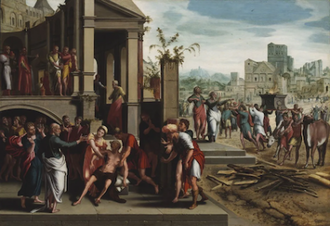Gospel in Art: Feast of Saint Barnabas, Apostle

Saints Paul and Barnabas in Lystra, by the Master of the Budapest Saints Paul and Barnabas © Museum of Fine Arts, Budapest
Source: Christian Art
Gospel of 11 June 2024
Matthew 5:13-16
Jesus said to his disciples: 'You are the salt of the earth. But if salt becomes tasteless, what can make it salty again? It is good for nothing, and can only be thrown out to be trampled underfoot by men.
'You are the light of the world. A city built on a hill-top cannot be hidden. No one lights a lamp to put it under a tub; they put it on the lamp-stand where it shines for everyone in the house. In the same way your light must shine in the sight of men, so that, seeing your good works, they may give the praise to your Father in heaven.'
Reflection on the painting
Today we celebrate the feast of St Barnabas. Barnabas was a Levite from Cyprus. His birth name was Joseph, but the apostles gave him the name Barnabas, which means "son of encouragement" (Acts 4:36). Barnabas played a key role in the spread of Christianity, especially among Gentiles. He was known for his generosity, having sold a field he owned and giving the money to the apostles (Acts 4:37). When Saint Paul came to Jerusalem after his conversion, most of the Christians there wanted nothing to do with him for they had known him as a persecutor of Christians. But Barnabas, guided by the Holy Spirit was willing to take a calculated risk on Paul. They became great friends and travelled far and wide, sharing the Good News of Christ to the world. St Barnabas was also one of the Cypriots who founded (Acts 11:19-20) the church in Antioch, where he preached. Barnabas was present at the Council of Jerusalem, which addressed the issue of Gentile converts and whether they needed to follow Jewish law. He, along with Paul, argued successfully that Gentile converts did not need to be circumcised (Acts 15).
Our 16th century painting depicts Barnabas and Paul in Lystra, as recounted in Acts 14:8-20, Paul and Barnabas encountered a man crippled from birth who had never walked. Seeing that the man had faith to be healed, Paul called out for him to stand up, and the man was miraculously healed. The astonished crowd mistook Paul and Barnabas for gods, calling Barnabas Zeus and Paul Hermes, and they attempted to offer sacrifices to them, which we see being brought on the right of the painting. However, Paul and Barnabas vehemently rejected this, insisting they were mere humans and urging the people to turn to the living God. Despite their efforts to correct the misunderstanding, some Jews from Antioch and Iconium arrived, inciting the crowd to stone Paul and drag him out of the city, leaving him for dead (we see the stoning talking place in the distance on the right, outside the city walls). Miraculously, Paul survived and continued his missionary work after being helped by the disciples.
LINKS
Gospel in Art: https://christian.art/
Today's Reflection: https://christian.art/daily-gospel-reading/matthew-5-13-16-2024-2


















